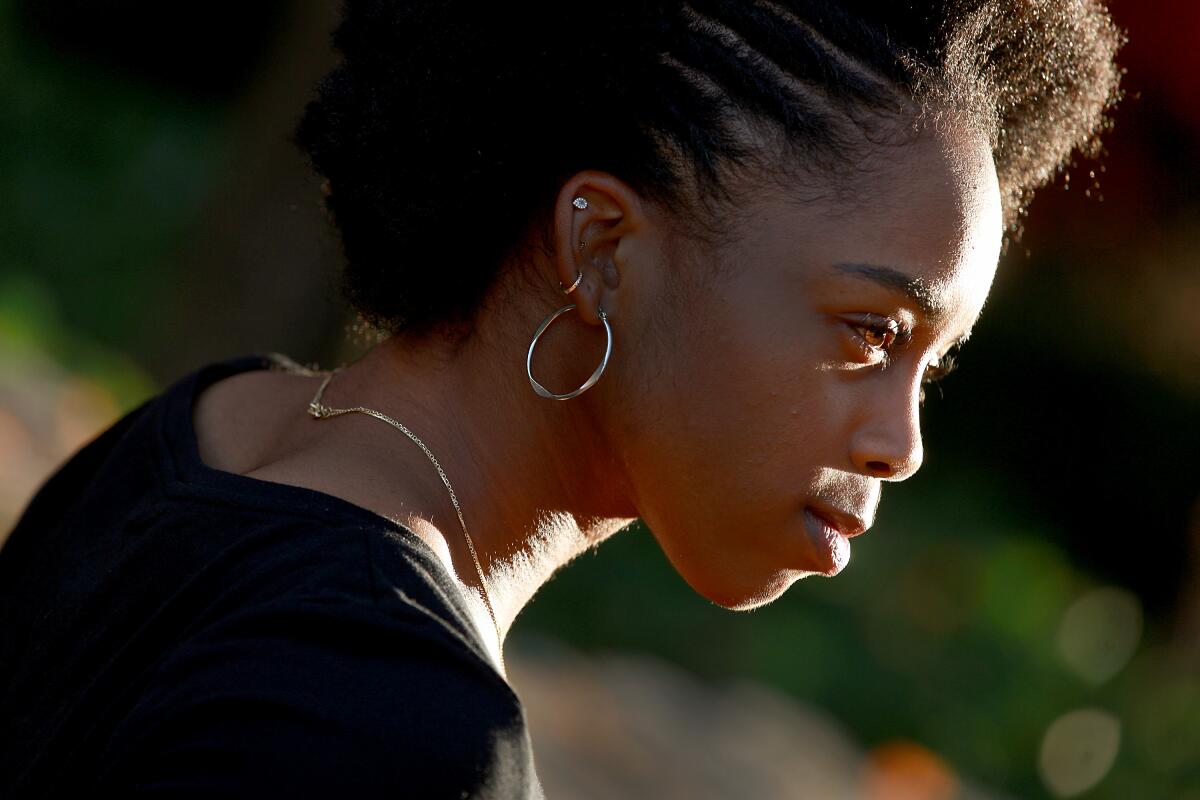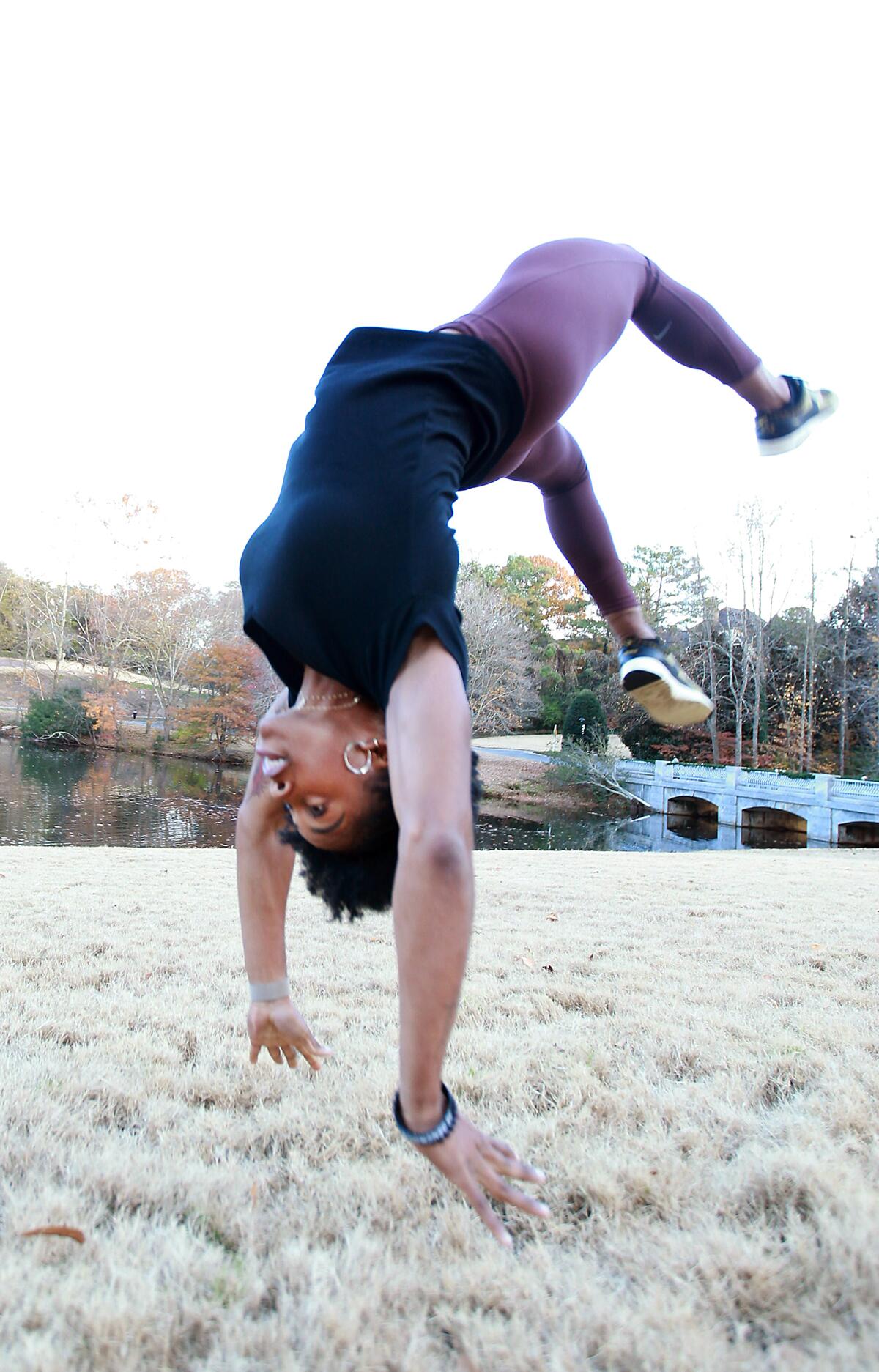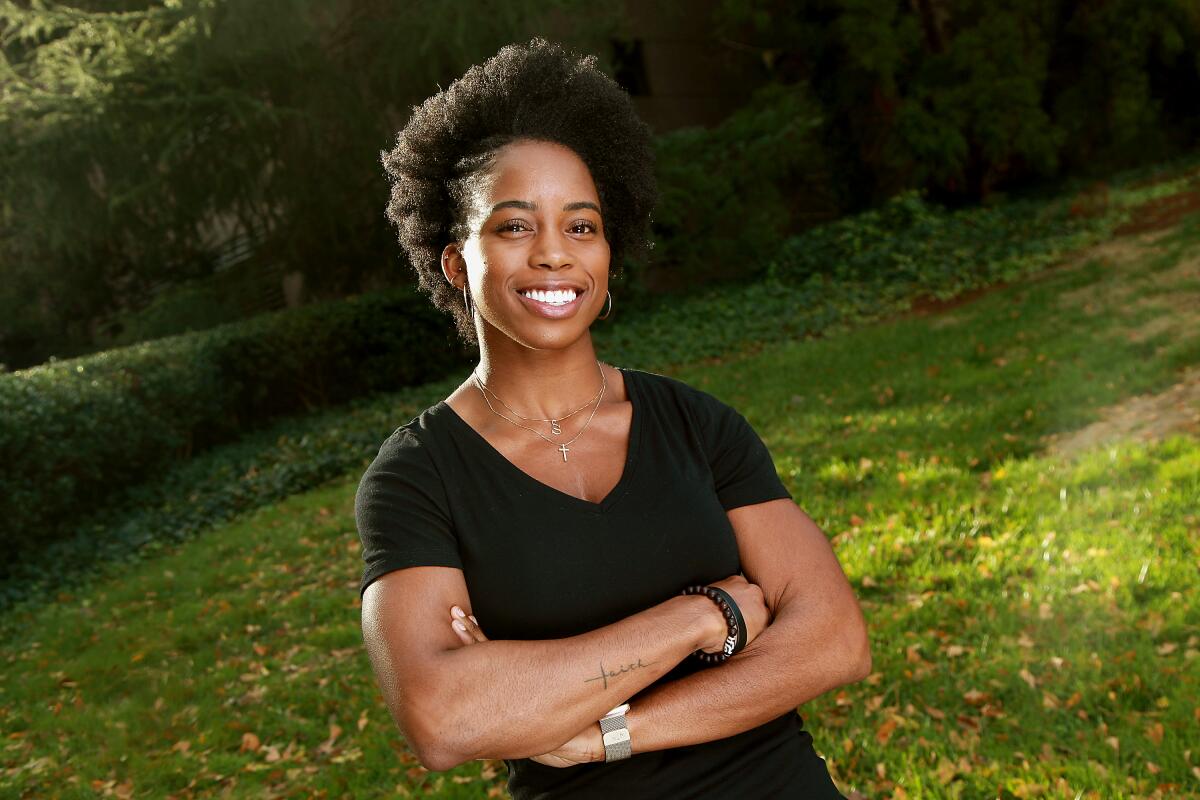Stunt work took her from UCLA gymnast to ‘Watchmen’ hero

- Share via
The fog clears, the music intensifies and Sadiqua Bynum gets to work. Wearing a black, hooded trench coat, she fires a single shot from a gun in her right hand before leaping onto the bed of a pickup truck, where an armed masked man awaits. When he tries to escape, she chases him into a bunkhouse, her gun drawn.
This is Bynum’s superhero moment, even though you can’t see her face as she cartwheels through the air and throws her nemesis to the ground. The gun is fake and the villain is an actor, but the action is real.
After a decorated gymnastics career at UCLA, Bynum, a three-time All-American, has jumped into the Hollywood stunt world and works as a double for Regina King in HBO’s “Watchmen.” The 26-year-old is one of the youngest and most successful black stuntwomen in an industry that is just beginning to experience the trickle-down effect of efforts to increase diversity in all of Hollywood.
Being a stuntwoman, she says, is the perfect job. “I’m constantly thinking that I have the ability ... to bring a different element to film and bring the skills that I have and make them bigger.”
In “Watchmen,” King portrays Angela Abar, a Tulsa, Okla., cop whose alter ego is Sister Night, a masked vigilante. She makes a show of retiring from police work to open a bakery but remains active on the force and in her secret identity. Sister Night wears a black cloak, covers her mouth with a mask and obscures her eyes with black spray paint as she assists the local police force. She’s a human who excels at combat.
Although the TV show, which airs its season finale Dec. 15, is inspired by Alan Moore and Dave Gibbons’ 1986-87 comic book series, the Sister Night character was created specifically for the HBO series. Bynum’s cartwheels and kicks help Angela Abar transcend her civilian persona: a mother of three trying to open a bakery.
Bynum, who graduated in 2016, has a stunt resume that includes appearances in “American Horror Story,” and the movies “Black Panther” and “Rampage.” But “Watchmen,” HBO’s most watched new series since “Big Little Lies,” has been a game changer.
After “Watchmen” wrapped, she landed a small role in “Richard Jewell,” the Clint Eastwood-directed drama, scheduled for release Dec. 13, about the security guard accused of setting off a bomb at the 1996 Olympics. In the film, which was shot in Atlanta’s Centennial Olympic Park, where the original bombing took place, Bynum portrays one of the people standing closest to the explosive device.
Thom Williams, who worked on both projects, knew he wanted to work with her again after seeing her work in “Watchmen.”
One of two stunt coordinators on the “Watchmen” pilot, Williams “discovered” Bynum when he came across a short highlight reel of her performing parkour-type stunts. He was dazzled by her ability to leapfrog over mats and transition smoothly into seemingly effortless flips. She combined power with grace and had an athletic build that would match King’s.
Bynum, Williams said, was perfect for Sister Night.
“A lot of times when you’re watching women’s gymnastics, it’s so beautiful and graceful, and Sadiqua had that,” said Williams, who worked with veteran stunt coordinator Doug Coleman on the pilot. “But she also had this insane power behind it.”
At UCLA, Bynum started as a walk-on. As a fifth-year senior, she ranked in the top eight nationally in floor exercise at the end of the regular season, earning her first-team All-American honors.
Her winning routine began with a double backflip with her body straight before landing on the mat with a glowing smile. Though gymnasts typically tumble from corner to corner, later in the routine Bynum executed a double tuck pass (two backflips with her knees to her chest) down the side of the mat, a much shorter distance. She generated the necessary power from just a single step.
That same power is evident in each episode of “Watchmen.” Justin Riemer, the stunt coordinator who took over after the pilot, points to the way Bynum runs on the set — as if she’s starting a tumbling pass or bounding down the vault runway.
::
Bynum flexed her superhero muscles early. As a toddler who started gymnastics at age 2, she wowed coaches at a local rec center by holding her weight up on the still rings with her elbows bent and hands by her ears. At 3, she lifted a couch while looking for something in the living room. The gymnastics classes at the rec center were intended for children up to the age of 8, but Bynum had completed them all by the time she was 4½.
She joined a gymnastics club in Emeryville, Calif., and progressed through the ranks, always practicing, no matter where she was. In preschool, she pulled herself up on tree branches as if she was performing a bar routine. (Teachers begged her parents to get her to stop because other kids were trying to imitate her stunts and they were falling out of trees.) She did floor routines down the aisles at grocery stores.
Bynum’s club career culminated in 2011 when she placed fifth in the all-around competition at the Level 10 state championships, the highest level of competition before elite (Olympic level) gymnastics.
But talent wasn’t the only thing that separated her from the rest of her peers.
In a sport in which competitors are predominantly white, Bynum recalls being one of maybe three or four black people in her gym while she was growing up.
“That was one of the things that made gymnastics really hard at times,” she said. “There were times when you realize you’re working really, really, really hard and the girl next to you is working not as hard but she’s getting coached more or she’s getting the praises and all that, and you’re over here like, ‘Why am I not getting the praises?’”
According to a 2007 study by USA Gymnastics , nearly three-quarters of about 19,000 gymnasts surveyed were white; only 6.61% were black. In 2009, only 7.6% of female Division I gymnasts were black, according to the NCAA. That number increased to 9.5% in 2018. Women’s gymnastics didn’t have a black Olympic all-around champion until 2012, when Gabby Douglas took the title. Four years later Simone Biles became the second black woman to win the title, and she is now the most decorated gymnast in the sport.
Bynum was adopted by white parents, and her older brother and sister were also adopted. She was always aware of diversity, she said, starting with her own family.
Conversations with her mother, Louisa, and club coach Katreece Roberts, who is black, helped keep Bynum focused.
“We spent a lot of time emphasizing that you don’t have to compare yourself” against other gymnasts, Louisa said. “You just have to be the best you, you can be.”
Bynum continues to carry that message into her stunt career, where women and performers of color still work under the shadow of “wigging” — when male stunt performers wear wigs to perform as women — and “paint-downs” — when white actors are painted and perform as people of color.
Though both practices are condemned by the Screen Actors Guild-American Federation of Television and Radio Artists, they aren’t obsolete. In 2014, Warner Bros. hired a white stuntwoman for a black actress on the Fox TV show “Gotham,” before inquiries from Deadline prompted the studio to recast the stunt performer. Veteran stuntwoman Deven MacNair filed a complaint to the Equal Employment Opportunities Commission in 2017 after a 2016 incident in which she saw a stuntman wearing a wig double for Kate Bosworth on the set of “The Domestics.” The stunt coordinator claimed the stunt was “too unsafe” for a woman, according to the complaint.
“That’s what motivates me to be able to be as well-rounded as I can,” Bynum said. “I don’t want someone to be able to say, ‘We don’t have a black stuntwoman that can do this.’”
Given her gymnastics background, Bynum specializes in flips, but she is expanding her repertoire. Dave Macomber, the fight coordinator for “Watchmen,” worked with her on fighting skills by running the 5-foot-5 gymnast through boxing drills with gloves and bags.

She’s learned to ride bareback, controlling a galloping horse with one hand while holding props with the other. After taking special stunt driving courses, she practices in open warehouse parking lots. Curious security guards sometimes watch from afar as she burns tire marks into the concrete. Other times they politely ask her to leave.
She admits that expanding her skills isn’t always enough to translate into confidence as she navigates the hyper-competitive stunt world. Her body — lean, muscular, with strong shoulders and sculpted legs — was built through years of gymnastics, but she hears whispers among other stuntwomen that skinnier performers can be more successful because they conform with the actresses typically cast in movies and TV. At times, Bynum has wondered if she should try to lose her muscles to get better roles.
Her older sister Zoe will have none of it.
“She has a great body,” said Zoe, who is three years older than Bynum. “Anybody would want that body, and people that hate on that body, you don’t need them in your life.”
“As long as I’m comfortable in my own skin and I’m doing what I can to be happy with how I look, then work will come if it’s there,” Bynum said. “And if not, if I’m too muscular for [an] actress, then I’ll find someone else who I fit better with.”
King, 48, said in an email that she made it clear to the “Watchmen” team that she wanted a stunt double who matched her body type and her running style. “They heard me and found Sadiqua,” the Oscar winner said. “We met, and we knew we were the perfect fit.”
Williams said he encountered Bynum’s demo reel on the @StuntPOC Instagram account. It was created by Jwaundace Candece, who was the driving double for King in “Watchmen,” in an effort to provide exposure for qualified stunt performers of color in the United States and Canada. The Stunt POC website lists more than 200 stunt performers, coordinators and directors.
“What I have found in the last couple years, which is really encouraging, is there’s more training opportunities, there’s more people going out there and busting their butts and working hard and making their abilities better and better,” Williams said. “So now we do have a much larger pool to draw from.”
::
As Bynum was preparing for graduation in 2016, she was looking into different jobs in fields such as sales or networking. She’d majored in sociology and at one point thought she might become a social worker — but eventually she decided she couldn’t stand sitting behind a desk all day. Former UCLA assistant gymnastics coach Randy Lane suggested that she might think about stunts, a path pursued by many other former Bruins.
Heidi Moneymaker, who graduated in 1999 and has more than 80 stunt credits to her name, doubled for Scarlett Johansson as Black Widow in the Marvel movies. Vanessa Zamarripa, a 19-time All-American at UCLA, worked on “Terminator: Dark Fate.” Natalie Padilla, a 2008 UCLA graduate who worked on “Wonder Woman” and “Justice League,” broke into stunts by performing on the ABC Family gymnastics show “Make It or Break It,” and gave Bynum advice on how to get started.
When Williams came across Bynum’s highlight reel, he called Padilla for background information — and she gave her fellow UCLA gymnastics alumna a rave review.
Bynum impressed the stunt coordinators on the set of “Watchmen” with her ability to pick up choreography quickly. During her first major fight scene of the series, Bynum cartwheels over her target’s arm, lands on her feet, and then throws a man — who must be 100 pounds heavier than she is — onto the ground as she rolls to her back. After watching different videos for reference, Bynum had the sequence down in five minutes.
“Sadiqua is a peerless athlete, No. 1,” said Macomber, the fight coordinator. She “can move and she picks up on things so well and so fast. She’s relatively new to the stunt industry … but her ability to mimic is really, really fantastic.”
Starting out, Bynum’s biggest challenge may have been overcoming a gymnast’s need for precision. After 20 years of having perfectly straight legs in gymnastics, she needed to learn how to perform “dirty” — no one points their toes as they’re thrown across a living room or capturing bad guys.

Bynum’s face lights up when she talks about her work. She played her own character in “Black Panther,” running through the fields of Wakanda as Dora Milaje, one of the fictional country’s female warriors. But she calls “Watchmen” more meaningful because she was “part of something that was building a character.”
Even if Sister Night doesn’t have superhuman powers, Bynum said, she cherishes the opportunity to portray a strong female character who fights. She’s noticed an increase in the number of films featuring women of color such as “Harriet” and “Queen & Slim” and hopes there will be even more roles for her. Those who have worked with her are sure of it.
“She’s going to be a rock star,” Macomber said. “I have no doubt. [She’s] going to be so in demand, she’s never going to stop working.”
More to Read
Sign up for Essential California
The most important California stories and recommendations in your inbox every morning.
You may occasionally receive promotional content from the Los Angeles Times.









